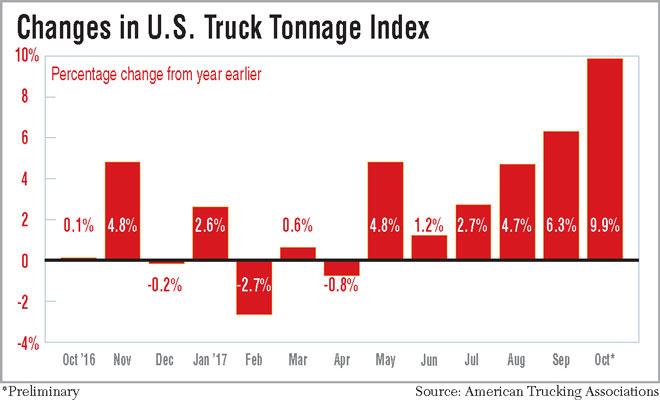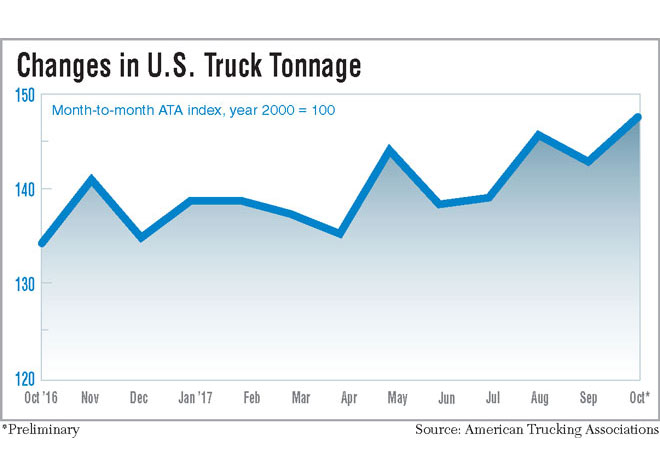Truck Tonnage Surges in October

Freight surged in October and carriers are bracing for what could be a record-breaking holiday shipping season.
American Trucking Associations said its seasonally adjusted for-hire truck tonnage index climbed to 147.6 in October, a 9.9% jump from the same month a year ago and a 3.3% gain from September.
“Continued improvement in truck tonnage reflects a much stronger freight market,” said ATA Chief Economist Bob Costello. “This strength is the result of several factors, including consumption, factory output, construction and improved inventory levels throughout the supply chain.”
A rise in tonnage of 6.7% over the past four months, he said, “suggests to me that retailers are expecting a good holiday spending season.


UPS Inc., the nation’s largest package carrier, said it expects to deliver a record 750 million packages this holiday season and the U.S. Postal Service said it expects to handle 850 million packages, a 10% increase from last year.
ATA calculates the tonnage index based on data provided by member companies, and it’s the latest in a string of upbeat reports on freight market conditions.
The DAT North American Freight Index, which tracks average prices paid for truck transportation based on roughly $33 billion in transactions between freight brokers and carriers, reached its highest level since 2014 in October, according to DAT Solutions, based in Portland, Ore.
October is typically a high point for contract freight associated with holiday retail and this year featured a surge of port traffic on both coasts, plus additional demand from recovery and rebuilding activities following hurricanes Harvey and Irma, that pushed more freight onto the spot market and boosted prices, said DAT Senior Industry Analyst Mark Montague.
Spot rates for dry van freight, including fuel, were $2.02 a mile in October, an increase of 37 cents compared to the same month in 2016. Likewise, the average rate for refrigerated freight was $2.31 per mile, the highest since December 2014, and the linehaul portion of the rate, excluding fuel, was the highest since 2010, DAT reported.
Rates for flatbed freight were $2.33 per mile in October, a 41-cent increase from the same month a year ago, reflecting strong demand due to storm recovery activity in Texas and Florida.
Another indicator of spot market trends, the Market Demand Index posted by Truckstop.com, a load board and financial services provider based in New Plymouth, Idaho, shows rates declining since peaking in late September but remain well above levels from a year ago.
Rates for truck equipment during the week of Nov. 14 were $2.27 per mile, up 24.4% from the same time period in 2016. An index of loads available for the same week was 112.1, a gain of 53.7% from a year ago.
Tim Denoyer, vice president and senior analyst for ACT Research in Columbus, Ind., said the company’s for-hire trucking index reached its highest level since 2011 in October with 29% of carriers surveyed reporting significant gains in volume and 18% reporting significant gains in pricing.
The Cass Freight Index, which measures shipments and expenditures based on more than $20 billion in annual freight payments handled by St. Louis-based Cass Information Systems, has been trending upward for much of the past year.
The shipments index for September, the latest data point available, is 3.2% higher than a year ago and the expenditures index is 4.6% higher than in September 2016.
“The overall freight recession, which began in March 2015, appears to be over and, more importantly, freight seems to be gaining momentum in most segments,” said Donald Broughton, managing partner of Broughton Capital and author of the Cass Freight Index Report.
Another company that processes freight payments, Minneapolis-based U.S. Bank, said its index for the third quarter shows a positive trend in national and regional freight activity, with the Northeast region showing the biggest gains in shipments and the Midwest region recording the biggest jump in spending due mainly to a pick up in manufacturing.
Higher demand for freight hauling and the inability of many carriers to expand because of a shortage of drivers is creating conditions that could result in higher rates for many shippers.
Also affecting rates will be shipper inefficiencies, according to Werner Enterprises CEO Derek Leathers and Estes Express Lines President Rob Estes, who participated in a webinar hosted by Mike Regan of TranzAct Technologies Inc. and Nasstrac, an association that represents less-than-truckload and parcel shippers.
“When they stated that the rates of a ‘tactical shipper’ will be 8% to 10% higher than a ‘strategic shipper,’ it raises all sorts of questions,” Regan said. “If your competitor is a ‘strategic shipper’ and your company is a ‘tactical shipper,’ it is going to cost you a lot more to move your freight.”




